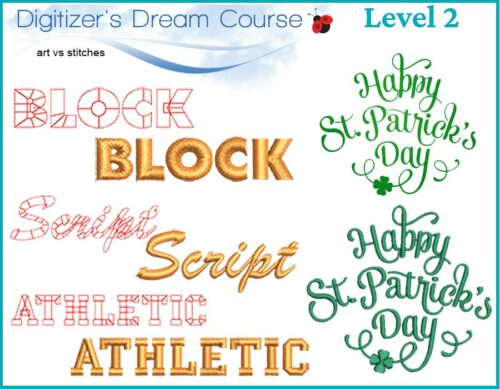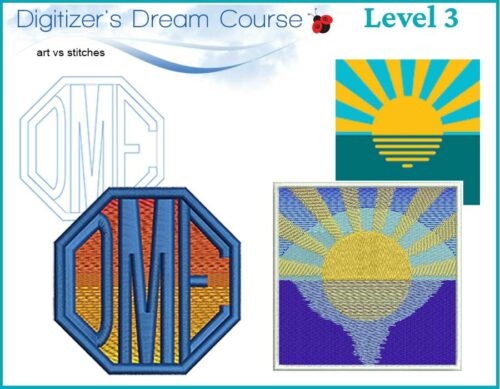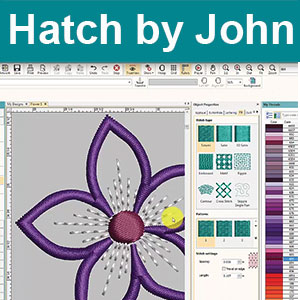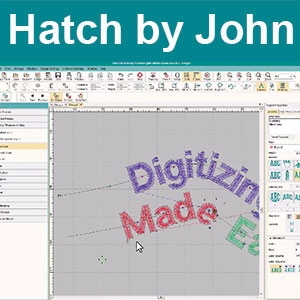-
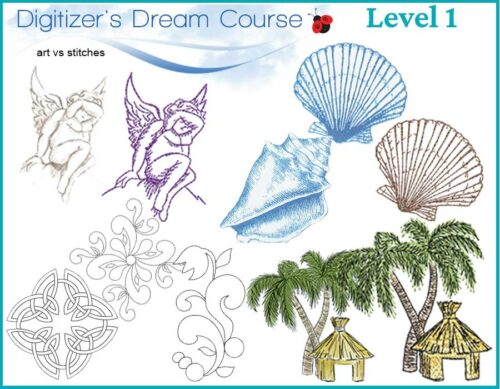 Level 1 is where we suggest everyone starts whether you’re completely new to digitizing or have been at it for a while. In this level, you’ll learn some of embroidery’s best kept ‘secrets’ & build a solid foundation of embroidery theory. This lesson heavily focuses on the running stitch as it is the primary stitch type used in machine embroidery.
Level 1 is where we suggest everyone starts whether you’re completely new to digitizing or have been at it for a while. In this level, you’ll learn some of embroidery’s best kept ‘secrets’ & build a solid foundation of embroidery theory. This lesson heavily focuses on the running stitch as it is the primary stitch type used in machine embroidery. -
 Complete the Digitizer’s Dream Course series with levels 2 & 3. Whereas Level 1 teaches you the theory and rules behind using the running stitch, levels 2 and 3 focus on the satin and fill stitches. These 3 stitch types are the pillars of machine embroidery. Once you’ve mastered them, the sky is the limit with this beautiful art!
Complete the Digitizer’s Dream Course series with levels 2 & 3. Whereas Level 1 teaches you the theory and rules behind using the running stitch, levels 2 and 3 focus on the satin and fill stitches. These 3 stitch types are the pillars of machine embroidery. Once you’ve mastered them, the sky is the limit with this beautiful art! -
-
-
 Level 1 is where we suggest everyone starts whether you’re completely new to digitizing or have been at it for a while. In this level, you’ll learn some of embroidery’s best kept ‘secrets’ & build a solid foundation of embroidery theory. This lesson heavily focuses on the running stitch as it is the primary stitch type used in machine embroidery.
Level 1 is where we suggest everyone starts whether you’re completely new to digitizing or have been at it for a while. In this level, you’ll learn some of embroidery’s best kept ‘secrets’ & build a solid foundation of embroidery theory. This lesson heavily focuses on the running stitch as it is the primary stitch type used in machine embroidery. -
 Complete the Digitizer’s Dream Course series with levels 2 & 3. Whereas Level 1 teaches you the theory and rules behind using the running stitch, levels 2 and 3 focus on the satin and fill stitches. These 3 stitch types are the pillars of machine embroidery. Once you’ve mastered them, the sky is the limit with this beautiful art!
Complete the Digitizer’s Dream Course series with levels 2 & 3. Whereas Level 1 teaches you the theory and rules behind using the running stitch, levels 2 and 3 focus on the satin and fill stitches. These 3 stitch types are the pillars of machine embroidery. Once you’ve mastered them, the sky is the limit with this beautiful art! -
 Level 1 is where we suggest everyone starts whether you’re completely new to digitizing or have been at it for a while. In this level, you’ll learn some of embroidery’s best kept ‘secrets’ & build a solid foundation of embroidery theory. This lesson heavily focuses on the running stitch as it is the primary stitch type used in machine embroidery.
Level 1 is where we suggest everyone starts whether you’re completely new to digitizing or have been at it for a while. In this level, you’ll learn some of embroidery’s best kept ‘secrets’ & build a solid foundation of embroidery theory. This lesson heavily focuses on the running stitch as it is the primary stitch type used in machine embroidery. -
 Level 1 is where we suggest everyone starts whether you’re completely new to digitizing or have been at it for a while. In this level, you’ll learn some of embroidery’s best kept ‘secrets’ & build a solid foundation of embroidery theory. This lesson heavily focuses on the running stitch as it is the primary stitch type used in machine embroidery.
Level 1 is where we suggest everyone starts whether you’re completely new to digitizing or have been at it for a while. In this level, you’ll learn some of embroidery’s best kept ‘secrets’ & build a solid foundation of embroidery theory. This lesson heavily focuses on the running stitch as it is the primary stitch type used in machine embroidery. -
 Complete the Digitizer’s Dream Course series with levels 2 & 3. Whereas Level 1 teaches you the theory and rules behind using the running stitch, levels 2 and 3 focus on the satin and fill stitches. These 3 stitch types are the pillars of machine embroidery. Once you’ve mastered them, the sky is the limit with this beautiful art!
Complete the Digitizer’s Dream Course series with levels 2 & 3. Whereas Level 1 teaches you the theory and rules behind using the running stitch, levels 2 and 3 focus on the satin and fill stitches. These 3 stitch types are the pillars of machine embroidery. Once you’ve mastered them, the sky is the limit with this beautiful art! -
 Complete the Digitizer’s Dream Course series with levels 2 & 3. Whereas Level 1 teaches you the theory and rules behind using the running stitch, levels 2 and 3 focus on the satin and fill stitches. These 3 stitch types are the pillars of machine embroidery. Once you’ve mastered them, the sky is the limit with this beautiful art!
Complete the Digitizer’s Dream Course series with levels 2 & 3. Whereas Level 1 teaches you the theory and rules behind using the running stitch, levels 2 and 3 focus on the satin and fill stitches. These 3 stitch types are the pillars of machine embroidery. Once you’ve mastered them, the sky is the limit with this beautiful art! -
-
 Level 1 is where we suggest everyone starts whether you’re completely new to digitizing or have been at it for a while. In this level, you’ll learn some of embroidery’s best kept ‘secrets’ & build a solid foundation of embroidery theory. This lesson heavily focuses on the running stitch as it is the primary stitch type used in machine embroidery.
Level 1 is where we suggest everyone starts whether you’re completely new to digitizing or have been at it for a while. In this level, you’ll learn some of embroidery’s best kept ‘secrets’ & build a solid foundation of embroidery theory. This lesson heavily focuses on the running stitch as it is the primary stitch type used in machine embroidery. -
-
 Complete the Digitizer’s Dream Course series with levels 2 & 3. Whereas Level 1 teaches you the theory and rules behind using the running stitch, levels 2 and 3 focus on the satin and fill stitches. These 3 stitch types are the pillars of machine embroidery. Once you’ve mastered them, the sky is the limit with this beautiful art!
Complete the Digitizer’s Dream Course series with levels 2 & 3. Whereas Level 1 teaches you the theory and rules behind using the running stitch, levels 2 and 3 focus on the satin and fill stitches. These 3 stitch types are the pillars of machine embroidery. Once you’ve mastered them, the sky is the limit with this beautiful art! -
-
-
-
-
 Level 1 is where we suggest everyone starts whether you’re completely new to digitizing or have been at it for a while. In this level, you’ll learn some of embroidery’s best kept ‘secrets’ & build a solid foundation of embroidery theory. This lesson heavily focuses on the running stitch as it is the primary stitch type used in machine embroidery.
Level 1 is where we suggest everyone starts whether you’re completely new to digitizing or have been at it for a while. In this level, you’ll learn some of embroidery’s best kept ‘secrets’ & build a solid foundation of embroidery theory. This lesson heavily focuses on the running stitch as it is the primary stitch type used in machine embroidery. -
 Complete the Digitizer’s Dream Course series with levels 2 & 3. Whereas Level 1 teaches you the theory and rules behind using the running stitch, levels 2 and 3 focus on the satin and fill stitches. These 3 stitch types are the pillars of machine embroidery. Once you’ve mastered them, the sky is the limit with this beautiful art!
Complete the Digitizer’s Dream Course series with levels 2 & 3. Whereas Level 1 teaches you the theory and rules behind using the running stitch, levels 2 and 3 focus on the satin and fill stitches. These 3 stitch types are the pillars of machine embroidery. Once you’ve mastered them, the sky is the limit with this beautiful art! -
-
-
-
 Complete the Digitizer’s Dream Course series with levels 2 & 3. Whereas Level 1 teaches you the theory and rules behind using the running stitch, levels 2 and 3 focus on the satin and fill stitches. These 3 stitch types are the pillars of machine embroidery. Once you’ve mastered them, the sky is the limit with this beautiful art!
Complete the Digitizer’s Dream Course series with levels 2 & 3. Whereas Level 1 teaches you the theory and rules behind using the running stitch, levels 2 and 3 focus on the satin and fill stitches. These 3 stitch types are the pillars of machine embroidery. Once you’ve mastered them, the sky is the limit with this beautiful art! -
-
-
 The Creative Digitizing Bundle is an exclusive bonus which you’ve received free for purchase level 1 of the ‘Digitizer’s Dream Course’. This non-software specific bundle has sold over 10,000 copies & will dive deep into the theory of digitizing. It will also teach more advanced techniques such as applique, fringe, foam, animals, nature & more.
The Creative Digitizing Bundle is an exclusive bonus which you’ve received free for purchase level 1 of the ‘Digitizer’s Dream Course’. This non-software specific bundle has sold over 10,000 copies & will dive deep into the theory of digitizing. It will also teach more advanced techniques such as applique, fringe, foam, animals, nature & more. -
 Level 1 is where we suggest everyone starts whether you’re completely new to digitizing or have been at it for a while. In this level, you’ll learn some of embroidery’s best kept ‘secrets’ & build a solid foundation of embroidery theory. This lesson heavily focuses on the running stitch as it is the primary stitch type used in machine embroidery.
Level 1 is where we suggest everyone starts whether you’re completely new to digitizing or have been at it for a while. In this level, you’ll learn some of embroidery’s best kept ‘secrets’ & build a solid foundation of embroidery theory. This lesson heavily focuses on the running stitch as it is the primary stitch type used in machine embroidery. -
 Level 1 is where we suggest everyone starts whether you’re completely new to digitizing or have been at it for a while. In this level, you’ll learn some of embroidery’s best kept ‘secrets’ & build a solid foundation of embroidery theory. This lesson heavily focuses on the running stitch as it is the primary stitch type used in machine embroidery.
Level 1 is where we suggest everyone starts whether you’re completely new to digitizing or have been at it for a while. In this level, you’ll learn some of embroidery’s best kept ‘secrets’ & build a solid foundation of embroidery theory. This lesson heavily focuses on the running stitch as it is the primary stitch type used in machine embroidery. -
-
-
-
 Complete the Digitizer’s Dream Course series with levels 2 & 3. Whereas Level 1 teaches you the theory and rules behind using the running stitch, levels 2 and 3 focus on the satin and fill stitches. These 3 stitch types are the pillars of machine embroidery. Once you’ve mastered them, the sky is the limit with this beautiful art!
Complete the Digitizer’s Dream Course series with levels 2 & 3. Whereas Level 1 teaches you the theory and rules behind using the running stitch, levels 2 and 3 focus on the satin and fill stitches. These 3 stitch types are the pillars of machine embroidery. Once you’ve mastered them, the sky is the limit with this beautiful art! -
0

